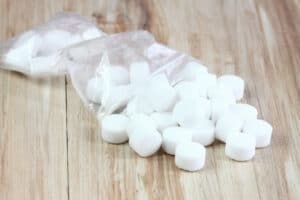If you’re considering where to discharge water softener backwash, it’s essential to note where and where you cannot disperse it. Primary locations where you can discharge water softener backwash would be in a french drain, dry well, or sewage system.
However, the backwash brine water is composed of high levels of minerals and salts, so it’s not ideal for discharging in fertile farmlands or areas populated by plants and animals.
Fortunately, there are other places where you can discharge water softener backwash. This guide will review our top four picks on where to drain backwash brine water, its functions, and more.

What is Water Softener Backwash Solution?
Water softener backwash is a solution composed of high sodium, potassium ions, and chloride levels. How it works is that the backwash solution flows through the resin tank, clearing out mineral buildup with high pressure. Afterward, the water is drained, and eventually, the backwash starts up to repeat the water-softening process.
Benefits of Using Water Softener Backwash
When considering using water softener backwash, there are a variety of advantages that come with this. Several of those benefits include the following:
- Deicing: One of the benefits of using water softener backwash is that it’s perfect for deicing surfaces, so you don’t have to stock up on salt for your driveway or sidewalk. It’s efficient in reducing snow faster than freshwater.
- Keeping your garden slug free: Water softener backwash is a perfect deterrent for getting rid of garden slugs. However, do not use excessive amounts, as it can kill your plants.
- Getting rid of weeds: Although excessive softener backwash harms vegetation, a safe amount is ideal for killing weeds or other bacteria. Though, it’s vital to be aware of where you discharge it, as you can’t place it in your garden’s flower bed.
How To Drain Your Water Softening System

Before you consider where to discharge your water softener backwash, it’s vital to know how to drain your water softening system. Below, we will provide a tutorial on how to do so.
Vacuum the Water Out of the Tank
The first thing you want to do is suck or vacuum out the water from the resin tank. High pressure will help remove sediment, dirt, or other particles buildup gradually over time. After you have vacuumed and cleaned out the tank, rinse it thoroughly to eliminate any remaining elements.
Regenerate Your Water Softener
If you’re looking to speed up the process of draining your water-softening system, you can always try to set your softener system to start the manual regeneration process. Although some would like to perform this step before vacuuming the water out of the tank, this helps you skip the cycle once the brine solution tank is entirely drained.
Pour the Remaining Water Into the Drain
The next step is to drain the remaining water from the brine tank into the drain. First, bypass the water, then carefully remove the salt grid and the overflow hose. Once removed, you can take out the tank, and the brine float, pour out the remaining water and empty it into the drain.
Places To Discharge Water Softener Backwash

So now that you know how to drain your water-softening system, you need to know where to discharge your softener backwash solution. Below, we will review several places you can do so.
Discharging Water Softener Backwash Outside
One of the primary places you can dump out your water softener backwash is outside. However, if you do this outside, please be aware of certain areas where you cannot disperse this.
- Septic drain field: This is one of the primary places to disperse your water softener backwash. To ensure that your septic drain field is over a drain field, how you can do this is take an old septic tank, remove its outlet pipe, and poke small holes at the bottom of it. Lastly, place pea stone in your old septic tank, then connect it with your water softener.
- Dry well: Dry wells are another perfect spot to disperse your softener backwash in. They’re typically deep, which allows the backwash to soak back into the ground.
- French drain: A french drain is a perforated pipe placed horizontally in a trench filled with rock or gravel. A french drain helps to disperse the solution efficiently over a large area.
Discharging Backwash to the Surface
Even though dispersing backwash to the surface is a solution you can try out, it’s not recommended as, during cold climates, it might freeze your brine and risk being exposed to people, plants, and animals. In this case, ensure that you contain it within your property, preferably where it can soak into the ground.
Discharging Backwash to the Subsurface
Discharging Backwash to the subsurface is safe so long as you ensure you have maximum space to work with. Measure and maximize the distance between your discharged brine solution and the well. The preferred distance is about 100 feet to keep the discharge downhill from drinking water sources.
Discharging Water Softener Backwash Inside
If you want to discharge your water softener inside, the primary setting to complete this task would be in the basement. From here, there are a couple of solutions to do so, one of them being a sump pump, as it can discard water after it pushes up a particular height. Another way to disperse backwash is a sewage ejector pump.
Summary
So, if you’re wondering where to discharge water softener backwash, you now know you can always discharge your softener backwash in a dry well or french drain. Other good places are a drain field, surface, subsurface, septic tank, and more.
Remember, when discharging your water softener backwash, you must avoid a few places, including around fertile farm grounds, nearby water sources, or populated areas with animals and plants.
Of course, when in doubt, contact your city’s municipal service center for more information.






